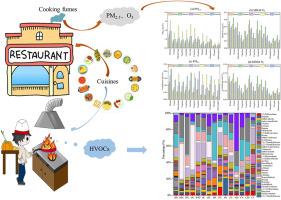全面评估不同菜系烹饪油烟对大气的影响和健康风险
IF 4.2
2区 环境科学与生态学
Q2 ENVIRONMENTAL SCIENCES
引用次数: 0
摘要
餐饮企业排放的污染物对环境和公众健康构成重大威胁。本研究在系统分析不同菜系挥发性有机化合物(VOC)排放特征的基础上,利用生成潜力计算和 WRF-CAMx 模拟,评估了餐饮企业烹饪排放对大气中 PM2.5 和 O3 浓度的贡献。评估了厨房呼吸区挥发性有机化合物的健康暴露风险以及餐饮企业产生的 PM2.5 和 O3 的健康暴露风险。生成潜势计算结果显示,餐饮企业的臭氧形成潜势(OFP)为 2.21-5.00 gO3/gVOCs,二次有机气溶胶生成潜势(SOAP)为 0.07-0.21 gSOA/gVOCs。WRF-CAMx 模拟结果表明,餐饮企业的烹饪排放对 PM2.5 和臭氧的最大日 8 小时平均浓度(MDA8)分别有 0.36-1.91 μg/m3 和 0.05-0.21 μg/m3 的贡献。南方城市餐饮企业的 PM2.5 和 O3 健康暴露风险高于北方城市,市区高于郊区。厨房呼吸区的有害挥发性有机化合物(HVOCs)平均浓度介于 53 ± 16 至 357 ± 31 μg/m3 之间。在所有挥发性有机化合物种类中,丙烯醛是造成危害指数(HI)的主要因素,占 50.9%-99.5%。所有菜肴的终生总致癌风险增量(ILCR)都超过了 1.00 × 10-6 的可接受阈值。这些研究结果有助于餐饮业制定和实施污染物缓解战略。本文章由计算机程序翻译,如有差异,请以英文原文为准。

A comprehensive evaluation of the atmospheric impacts and health risks of cooking fumes from different cuisines
Pollutants emitted by catering enterprises pose a significant threat to the environment and public health. In this study, based on a systematic analysis of volatile organic compound (VOC) emission characteristics of different cuisines, the contribution of cooking emissions from catering enterprises to the PM2.5 and O3 concentrations in the atmosphere was evaluated using generation potential calculations and WRF-CAMx simulations. The health exposure risks of VOCs in kitchen breathing areas and those of PM2.5 and O3 contributed by the catering enterprises were evaluated. The generation potential calculation results showed that the catering enterprises exhibit 2.21–5.00 gO3/gVOCs of ozone formation potential (OFP) and 0.07–0.21 gSOA/gVOCs of secondary organic aerosol production potential (SOAP). The WRF-CAMx simulation results indicated that cooking emissions from catering enterprises contribute 0.36–1.91 μg/m3 and 0.05–0.21 μg/m3 to PM2.5 and maximum daily 8-h average (MDA8) concentrations of O3. The health exposure risks of PM2.5 and O3 were higher in catering enterprises in southern cities than in northern cities and were higher in urban areas than in suburban areas. The average hazardous VOCs (HVOCs) concentrations ranged from 53 ± 16 to 357 ± 31 μg/m3 in kitchen breathing areas. Acrolein was the primary contributor to the hazard index (HI) of all VOC species, accounting for 50.9%–99.5%. The total incremental lifetime carcinogenic risk (ILCR) of all cuisines exceeded the acceptable thresholds of 1.00 × 10−6. These findings provide insights that can aid in the formation and implementation of pollutant mitigation strategies in the catering industry.
求助全文
通过发布文献求助,成功后即可免费获取论文全文。
去求助
来源期刊

Atmospheric Environment
环境科学-环境科学
CiteScore
9.40
自引率
8.00%
发文量
458
审稿时长
53 days
期刊介绍:
Atmospheric Environment has an open access mirror journal Atmospheric Environment: X, sharing the same aims and scope, editorial team, submission system and rigorous peer review.
Atmospheric Environment is the international journal for scientists in different disciplines related to atmospheric composition and its impacts. The journal publishes scientific articles with atmospheric relevance of emissions and depositions of gaseous and particulate compounds, chemical processes and physical effects in the atmosphere, as well as impacts of the changing atmospheric composition on human health, air quality, climate change, and ecosystems.
 求助内容:
求助内容: 应助结果提醒方式:
应助结果提醒方式:


